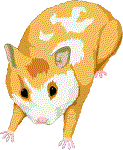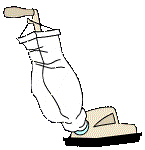
The Photo Spot
|
 |
||||
|
1. a rodent somewhat like a mouse but larger. Hamsters have a short tail and large cheek pouches. They are often kept as pets or used in scientific work and are native to Europe and Asia.
![]() Back to top
Back to top
 Comments
CommentsMy experience with hamsters began about 15 years ago when my son was given two hamsters for his birthday. I had a small family daycare at the time, and we were thrilled with our new little friends. Oh dear... it turned out that they were a male and a female, and you can guess the rest. Everyone in the neighbourhood ended up with their very own hamster! I learned my first rule of hamsters then and there... one hamster per cage! Another note... be careful that you purchase a very young hamster too... it’s quite possible to bring home a hamster that is already pregnant!
I’m sure that the most consistently favourite pet in my classroom is our hamster. He’s soft and cute and definitely has an adorable little face. However, some individual hamsters bite more than others, and a hamster bite really hurts. Our hamster is never allowed out unless I am in the room and everyone knows that you only handfeed “long” treats! Hamsters are basically nocturnal, so most of the day our little guy is sleeping. He has two scheduled “disturbances” and the rest of the day is pretty well his to sleep away! Each day the “Classroom Zoologist” is allowed to pet and handfeed the hamster in the course of his/her duties. The other time is during our “shared reading” time (ie noisy reading!). The hamster has a turn “being read to” as he rolls around in his hamster ball (which is mounted on a stand).
The weekly cage cleaning is not too difficult, but you don’t want to let overlook it or the scent is most unpleasant! Most hamsters choose one corner of their cage to pee in, which is very handy for daily quick clean-ups. Some hamsters will even pee in a little jar on its side! My latest hamster, however, also pees in his plastic wheel. This does not add to his attractiveness! Good thing he’s cute!
Our tank set-up at school used to be a 10 gallon tank with a home-made wire lid (held down with two straps) and a tube extension pointing up to small plastic “bedroom”. It worked perfectly well and I was not planning on making any changes. However, I was fortunate to be offered a complimentary Hagan Habitrail Teacher Package a year or so ago. It included a wonderful plastic home complete with exercise wheel, tube extension to a “bedroom”, and puzzle cube hide-out. It is really nice! It cleans easily and so far I have not had any trouble with scratching the plastic during cleaning or with the hamster chewing its way out. Someday I hope to take my bag of mismatched tubes and make a further extension to an older plastic model set-up that someone donated this year. Then our hamster would have two full floors and a penthouse!
![]() Back to top
Back to top
A hamster cage should be about the size of a 10 gallon tank or larger. The advantage of a tank is that the substrate doesn’t end up all over the floor. Wire cages are light and cheap, but the mess from the litter substrate floating around can be quite a nuisance. All-plastic cages are light and keep the mess inside. You have to be careful when cleaning them, however, or you can scratch the finish. Nowadays there are many delightful and expensive additions to make your hamster’s home a carnival of tubes, rooms, and play activities. Just remember that each of these additions will have to be taken apart and scrubbed! Moderation is a good plan! One essential item is a sturdy, escape proof lid. A hamster can easily wedge its “toys” into a pile and climb to the top.
They are masters at gnawing, so check all possible exits daily. If your hamster does escape, search all edges, nooks, and crannies of your classroom for signs of chewing. A hamster trap can often do the trick if he doesn’t show up. Put some food in a bucket and place a wood ramp (board) going up to it. Wipe the board with a carrot and add a few seeds at the bottom. The hamster will nibble his way up and fall into the bucket! It works! (I know!)
The substrate most commonly used is pine chips (do NOT use cedar chips). There are also substrates made of corn pellets and of a shredded papery substance, but these are more expensive. I have also seen (in a book) a wonderful “basement floor tank” which is filled with soil for the hamster to burrow in! I have no idea what condition the hamster will be in afterwards, but someday I would definitely like to try it! In their natural environment, hamster live underground in lairs (burrows). These burrows have separate compartments for nesting, food, storage, and body wastes.
Your hamster will enjoy having some kind of cozy spot to sleep in. Even a Kleenex box will suffice. Adding some Kleenex tissues, a piece of paper towel, shredded newspaper, or some commercial “hamster bedding” will help keep your little fellow cozy too.
Your hamster needs a chance to exercise daily. In the wild it may run as far as eight kilometers (five miles) in search of food. Provide an exercise wheel which it has free access to during the night.
You will need a sturdy, non-tipping dish for food and some kind of a water bottle. Water dishes are not advised. Be sure the water bottle is not in an area where the hamster will bump it or the water will drip into the cage. The bottom of the cage must remain dry.
![]() Back to top
Back to top
There are many commercial hamster foods available. Purchase a good quality fortified diet which does not have too many fatty sunflower seeds. Hamsters tend to gobble these down and leave the healthier foods. They also will also sometimes move the seeds around to “caches” within the cage, so don’t always assume that everything was eaten. Supplement your hamster’s diet with small quantities of nutritious fresh foods daily like broccoli, carrots, apple and other fruits and vegetables. Wash the foods well but don’t peel them. Be careful not to feed too much fresh food or your pet can get a stomach ache or diarrhea.
Provide fresh water daily. Wash the water bottle right out, don’t just fill it.
Provide something for your hamster to gnaw on, like a clean twig from an apple tree or commercial wood gnaws for rodents.
![]() Back to top
Back to top
 Maintenance
MaintenanceThe whole cage should be cleaned thoroughly once a week with hot soapy water and some disinfectant like pine sol. Be sure to completely dry the cage before adding the wood shavings. (Save a little of the old shavings so that the cage still smells like “home” though!).
Daily maintenance involves removing any uneaten fresh foods and also the litter from the “bathroom area”. Some hamsters will nicely pee in a wide mouthed jar on its side if you place a little damp/ soiled litter in it and put it in the same spot where the hamster chose to pee. This makes clean up easy. Another suggestion I read about is to use a small tin lid with cat litter in it!
![]() Back to top
Back to top
Hamsters are members of the rodent order of mammals, including guinea pigs, gerbils, mice, squirrels, and beavers. Like all mammals, they give birth to live young and nurse with milk. Rodents have continuously growing front incisor teeth, which is why they are always gnawing. The word hamster comes from the German word “hamstern”, which means “hoard”. Hamsters are omnivores and eat plants, seeds, insects, earthworms etc. There are different types of hamsters originating from North Asia (Siberian) , Russia (Djungarian or Russian), Mongolia (Roborovsky), and China (Pygmy or Chinese). Today’s most common hamsters are descendants of 6 hamsters which were discovered in Syria in 1930!
![]() Back to top
Back to top
 Characteristics
Characteristics• Hamsters are nocturnal (sleep in the day) but are also crepuscular (twilight active)
• They have huge cheek pouches which they use to transport food or nesting materials back to their homes. These cheeks extend from the mouth down to the shoulders!
• They live in lairs underground with mazes of tunnels leading to different rooms.
• They have short stocky bodies, short legs and a tiny stub of a tail.
• Their feet are very good at grasping and digging.
• They like to sit up on their hind legs to look around.
• Their front incisor teeth are constantly growing and so they are constantly gnawing.
• They have poor eyesight, but good senses of hearing and of smell.
• Their round ears have soft flaps to funnel sounds into the ears.
• They have soft fur which is replaced about every 3 months.
• They don’t usually make any noise apart from a squeak or little bark when frightened.
• They mark their possessions by rubbing their scent on them.
![]() Back to top
Back to top
• Study the basic anatomy of the hamster. Look at the placement of the eyes, the soft ears, the long incisors, the short tail and the fine little paws.
• Observe the hamster before and after it fills its cheek pouches. Note the differences!
• Try to determine which dry foods your hamster prefers. Then try different fresh foods. An interesting variation of this is studying “high fat” versus “low fat” foods. Try to obtain the Hagan “Habitrail Hamsters & You” Educational Booklet for specifics!
• Try to determine “how much” food is needed to prompt your hamster to hoard it in caches.
• A hamster naturally travels through tunnels. Set up a maze of tunnels with food at one end. See how long the hamster takes to find the food. Try it again - can the hamster learn the maze?
• Hamsters can follow scent trails (that’s how you can recapture an escapee!). See if you can create scent trails by rubbing different fresh foods along a path. Can you see any differences in your hamster’s behaviour?
• How far do hamsters go when they run in their exercise wheels? Try to obtain the Hagan “Habitrail Hamsters & You” Educational Booklet for specifics!
![]() Back to top
Back to top
Evans, Mark, Hamster (ASPCA Pet Care Guides For Kids), Toronto, Canada: Stoddart Publishing Co. Ltd., 1994.
Petty, Kate, Hamsters (First Pets Series), U.S.A.: Aladdin Books Ltd., 1989.
Ragland, Kay, All About Hamsters, U.S.A.: TFH Publications, Inc., 1963.
Richards, Dr. Herbert, Hamsters in Color, U.S.A.: T.F.H. Publ., Inc., 1968.
Roberts, Mervin F., How to Raise and Train a Pet Hamster, U.S.A.: TFH Publications, Inc., 1979.
![]() Back to top
Back to top
Animal Health Center
Simple care sheet for hamsters
http://www.caringtogether.com/exotics/hamsters.html
BC SPCA
A simple care sheet for rodents
http://www.bcyellowpages.com/advert/b/BCHES/rodent.htm
Caleb’s Hamster Page
Good info. about Golden Hamsters
http://www.jps.net/caldwell/hamster_page/
Caleb’s Hamster Page
This site has a set of links to other hamster sites.
http://www.jps.net/caldwell/hamster_page/Links_page.html
The Complete Hamster Site
The ultimate hamster fancier’s web site! Lots of information and assorted facts on all the different types of hamsters.
http://www.hamsters.co.uk/index2.htm
The Electronic Zoo
General info. on hamsters.
http://netvet.wustl.edu/rodents.htm#hamster
Hagen Web site
Good basic information about hamsters.
http://www.rchagen.com/welcome.htm
Hamster Books
A list of books about hamsters.
http://planetpets.simplenet.com/bookham1.htm
The Hamster Page
Wow! Links to every hamster site imaginable, I’m sure!
http://www.tela.bc.ca/hamster/
National Hamster Council UK
Enthusiastic hamster owners from the UK.
http://www.angelfire.com/ok/nathamstercouncil/
The World of Pets
Links to other hamster sites.
http://ucsub.colorado.edu/~bcor1000/Rodent.html
| Getting around in this Web site |